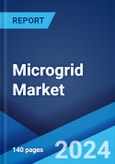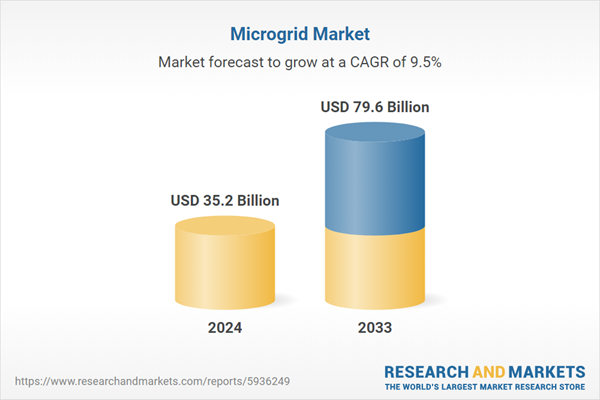A microgrid is a localized and small-scale energy system that generates, distributes, and manages electricity independently or in conjunction with the main power grid. It typically includes a combination of renewable energy sources, energy storage devices, and conventional generators. It can operate autonomously or disconnect from the main grid during power outages or emergencies and ensure a reliable and continuous power supply to a specific area or facility. As it is highly flexible and can be customized to meet unique energy needs, the demand for microgrid is increasing across the globe.
At present, the rising adoption of microgrids, as they promote energy efficiency, reduce reliance on fossil fuels, and enhance grid resilience, is bolstering the growth of the market. In line with this, increasing concerns about reducing greenhouse gas (GHG) emissions around the world are strengthening the growth of the market. Moreover, governing agencies of various countries are encouraging the adoption of microgrids by offering several incentives, which is contributing to the growth of the market. In addition, advancements in microgrid technology, such as improved control systems, energy storage solutions, and grid management software, are offering lucrative growth opportunities to industry investors. Furthermore, the rising demand for resilient infrastructure during natural disasters and cybersecurity threats is supporting the growth of the market. Apart from this, the increasing adoption of energy systems that have low transmission losses is impelling the growth of the market.
Microgrid Market Trends/Drivers:
Rising demand for enhanced energy security
The rising demand for enhanced energy security and reliability in various industries, communities, and critical facilities is bolstering the growth of the market. Traditional centralized power grids are vulnerable to disruptions from natural disasters, cyberattacks, and equipment failures, resulting in costly downtime and potential safety risks. On the other hand, microgrids offer a solution by providing a decentralized, self-sufficient energy system that can seamlessly disconnect from the main grid during outages. These grids use advanced control systems to detect grid disturbances and autonomously switch to island mode while ensuring an uninterrupted power supply. This capability is especially crucial for critical infrastructure like hospitals, data centers, and military bases, where continuous power is vital for survival.Increasing need for cleaner and more sustainable energy sources
The increasing need for cleaner and more sustainable energy sources is contributing to the growth of the market. In addition, these grids are ideally suited to incorporate renewable energy generation, such as solar panels and wind turbines. They can effectively balance the intermittent nature of renewables with energy storage systems and ensure a stable power supply. Apart from this, this integration of renewables assists in reducing reliance on fossil fuels, lowering greenhouse gas (GHG) emissions, and aligns with the sustainability goals. Furthermore, the rising demand for microgrids due to the declining costs of solar and wind technologies is propelling the growth of the market.Growing demand for cost-effective energy systems
The escalating demand for cost-effective energy systems to reduce the operational costs of a business is impelling the growth of the market. In line with this, microgrids allow organizations to generate power locally and efficiently, reducing the need to purchase expensive electricity from the grid. By optimizing the use of renewable energy sources, combined with energy storage and efficient demand management, these grids can significantly lower operational costs. Apart from this, for remote and off-grid applications, such as mining operations or rural communities, these grids provide an affordable and sustainable solution to access electricity and eliminate the need for expensive long-distance power transmission infrastructure, which is offering a positive market outlook.Microgrid Industry Segmentation:
The publisher provides an analysis of the key trends in each segment of the market forecast at the global and regional levels from 2025-2033. Our report has categorized the market based on energy source and application.Breakup by Energy Source:
- Natural Gas
- Combined Heat and Power
- Solar Photovoltaic (PV)
- Diesel
- Fuel Cell
- Others
Combined heat and power represent the largest market segment
The report has provided a detailed breakup and analysis of the market based on the energy source. This includes natural gas, combined heat and power, solar photovoltaic (PV), diesel, fuel cell, and others. According to the report, combined heat and power represented the largest segment. Combined heat and power (CHP), also known as cogeneration, is a dynamic solution that simultaneously produces electricity and utilizes the waste heat generated during the electricity generation process for heating or cooling purposes. CHP is predominantly fueled by natural gas, but it can utilize a range of energy sources, such as biomass, biogas, and even waste heat from industrial processes. This versatility makes it a highly efficient and sustainable option for both energy generation and thermal management. In addition, it offers enhanced energy efficiency as compared to traditional power generation methods. Furthermore, there is a rise in the demand for CHP grids in hospitals, universities, and industrial complexes due to their ability to enhance energy resilience, reduce energy bills, and contribute to sustainability goals is propelling the growth of the market.Breakup by Application:
- Remote Systems
- Institution and Campus
- Utility/Community
- Defence
- Others
Remote systems account for the majority of the market share
The report has provided a detailed breakup and analysis of the market based on the application. This includes remote systems, institution and campus, utility or community, defence, and others. According to the report, remote systems represented the largest segment. Remote systems are designed to provide electricity to areas that are geographically isolated or where access to the central power grid is impractical or cost-prohibitive. These remote systems are typically deployed in locations, such as off-grid communities, remote industrial sites, mining operations, and remote research stations. They play a critical role in addressing the energy needs of these isolated regions, improving the quality of life for residents, and supporting essential industrial processes. They can utilize renewable energy sources like solar panels and wind turbines, often combined with energy storage solutions, to generate clean and sustainable electricity and minimize environmental impact.Breakup by Region:
- North America
- Asia Pacific
- Europe
- Middle East and Africa
- Latin America
North America exhibits a clear dominance, accounting for the largest microgrid market share
The market research report has also provided a comprehensive analysis of all the major regional markets, which include North America, Asia Pacific, Europe, the Middle East and Africa, and Latin America. According to the report, North America accounted for the largest market share.North America held the biggest market share due to the presence of well-developed energy infrastructure. Apart from this, the rising awareness about maintaining sustainability is contributing to the growth of the market in the region. In line with this, increasing advancements in microgrid technology are propelling the growth of the market. Besides this, favorable government initiatives are supporting the growth of the market in the North America region.
Competitive Landscape:
Key players are improving the technologies of these grids by developing more efficient energy storage solutions, advanced control systems, and integrated renewable energy sources to enhance the performance and resilience of the product. Additionally, they are closely working with their clients to design and implement customized solutions tailored to specific energy needs and objectives. This involves assessing the unique requirements of each customer, such as industrial facilities, communities, or commercial properties, and designing these grids accordingly. Moreover, companies are developing grid-interactive microgrids that can both support local loads and provide grid services, such as frequency regulation and grid stabilization. They are also developing cost-effective and sustainable solutions that can operate independently and reliably in challenging environments.The report has provided a comprehensive analysis of the competitive landscape in the market. Detailed profiles of all major companies have also been provided.
Some of the key players in the market include:
- Lockheed Martin Corporation
- ABB Ltd
- General Electric Company (GE)
- Eaton Corporation PLC
- Siemens AG
Key Questions Answered in This Report
1. How big is the microgrid market?2. What is the future of microgrid Market?
3. What are the key factors driving the global microgrid market?
4. What has been the impact of COVID-19 on the global microgrid market growth?
5. What is the breakup of the global microgrid market based on the energy source?
6. What is the breakup of the global microgrid market based on the application?
7. What are the key regions in the global microgrid market?
8. Who are the microgrid market players?
Table of Contents
Companies Mentioned
- Lockheed Martin Corporation
- ABB Ltd
- General Electric Company (GE)
- Eaton Corporation PLC
- Siemens AG
Table Information
| Report Attribute | Details |
|---|---|
| No. of Pages | 142 |
| Published | January 2025 |
| Forecast Period | 2024 - 2033 |
| Estimated Market Value ( USD | $ 35.2 Billion |
| Forecasted Market Value ( USD | $ 79.6 Billion |
| Compound Annual Growth Rate | 9.5% |
| Regions Covered | Global |
| No. of Companies Mentioned | 5 |









